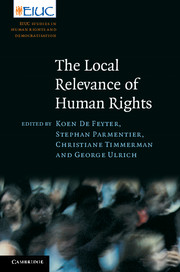Book contents
- Frontmatter
- Contents
- Contributors
- Series editors' preface
- Preface
- Abbreviations
- 1 Introduction: reconsidering human rights from below
- 2 Sites of rights resistance
- 3 Freedom from want revisited from a local perspective: evolution and challenges ahead
- 4 Relevance of human rights in the glocal space of politics: how to enlarge democratic practice beyond state boundaries and build up a peaceful world order
- 5 The local relevance of human rights: a methodological approach
- 6 Ensuring compliance with decisions by international and regional human rights bodies: the case of the European Committee for the Prevention of Torture
- 7 Building rights-based health movements: lessons from the Peruvian experience
- 8 Defining human rights when economic interests are high: the case of the western Shoshone
- 9 Struggling to localise human rights: the experience of indigenous peoples in Chile
- 10 Enforcing environmental rights under Nigeria's 1999 Constitution: the localisation of human rights in the Niger Delta region
- 11 Conflict resolution through cultural rights and cultural wrongs: the Kosovo example
- 12 Epilogue: widening the perspective on the local relevance of human rights
- Index
- References
9 - Struggling to localise human rights: the experience of indigenous peoples in Chile
Published online by Cambridge University Press: 07 October 2011
- Frontmatter
- Contents
- Contributors
- Series editors' preface
- Preface
- Abbreviations
- 1 Introduction: reconsidering human rights from below
- 2 Sites of rights resistance
- 3 Freedom from want revisited from a local perspective: evolution and challenges ahead
- 4 Relevance of human rights in the glocal space of politics: how to enlarge democratic practice beyond state boundaries and build up a peaceful world order
- 5 The local relevance of human rights: a methodological approach
- 6 Ensuring compliance with decisions by international and regional human rights bodies: the case of the European Committee for the Prevention of Torture
- 7 Building rights-based health movements: lessons from the Peruvian experience
- 8 Defining human rights when economic interests are high: the case of the western Shoshone
- 9 Struggling to localise human rights: the experience of indigenous peoples in Chile
- 10 Enforcing environmental rights under Nigeria's 1999 Constitution: the localisation of human rights in the Niger Delta region
- 11 Conflict resolution through cultural rights and cultural wrongs: the Kosovo example
- 12 Epilogue: widening the perspective on the local relevance of human rights
- Index
- References
Summary
The context
According to recent statistics, the population that indentifies itself as indigenous in Chile numbers 1,060,786 people, corresponding to 6.6 per cent of the country's population. Most of these identify themselves as Mapuche (87.2 per cent). The rest identify themselves as Aymara (7.8 per cent), Atacameño or Lickanantai (2.8 per cent), Diaguita (0.8 per cent), Quechua (0.6 per cent), Colla (0.3 per cent), Rapa nui (0.2 per cent), Kawéskar (0.2 per cent) or Yagán (0.1 per cent). As a result of migration since the late nineteenth century, when the Chilean state occupied most of the ancestral homelands of these peoples, 69.4 per cent of the indigenous population now live in urban areas and 27.1 per cent of the total indigenous population lives in the Metropolitan Region of Santiago.
Indigenous peoples in Chile, as well as those that identify themselves as such, are victims of various forms of discrimination. Their political discrimination is reflected in their lack of representation in the state institutions making decisions that concern them, such as the National Congress, and in local and regional governments. This phenomenon is also reflected in their lack of representation in positions of hierarchy within the executive branch of the state, the judiciary and the armed forces. Discrimination is also reflected in their social and economic marginalisation, particularly when compared to the non-indigenous population. Cultural discrimination, although less evident than in the past, is still visible in the exclusion of indigenous languages and voices in educational programmes as well as in the mainstream media.
- Type
- Chapter
- Information
- The Local Relevance of Human Rights , pp. 240 - 269Publisher: Cambridge University PressPrint publication year: 2011

